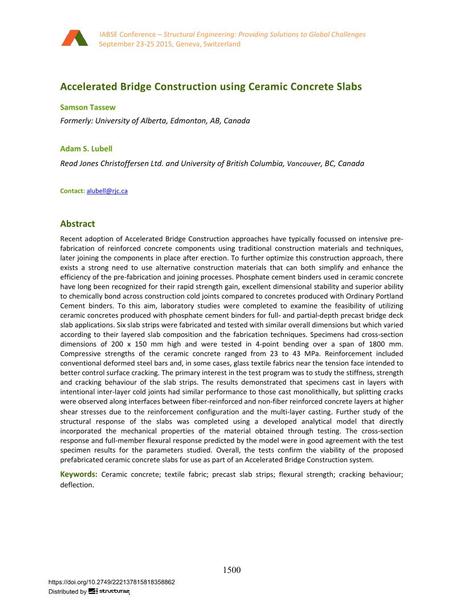Accelerated Bridge Construction using Ceramic Concrete Slabs

|
|
|||||||||||
Détails bibliographiques
| Auteur(s): |
Samson Tassew
(Formerly: University of Alberta, Edmonton, AB, Canada)
Adam Lubell (Read Jones Christoffersen Ltd. and University of British Columbia, Vancouver, BC, Canada) |
||||
|---|---|---|---|---|---|
| Médium: | papier de conférence | ||||
| Langue(s): | anglais | ||||
| Conférence: | IABSE Conference: Structural Engineering: Providing Solutions to Global Challenges, Geneva, Switzerland, September 2015 | ||||
| Publié dans: | IABSE Conference Geneva 2015 | ||||
|
|||||
| Page(s): | 1500-1507 | ||||
| Nombre total de pages (du PDF): | 8 | ||||
| Année: | 2015 | ||||
| DOI: | 10.2749/222137815818358862 | ||||
| Abstrait: |
Recent adoption of Accelerated Bridge Construction approaches have typically focussed on intensive pre- fabrication of reinforced concrete components using traditional construction materials and techniques, later joining the components in place after erection. To further optimize this construction approach, there exists a strong need to use alternative construction materials that can both simplify and enhance the efficiency of the pre-fabrication and joining processes. Phosphate cement binders used in ceramic concrete have long been recognized for their rapid strength gain, excellent dimensional stability and superior ability to chemically bond across construction cold joints compared to concretes produced with Ordinary Portland Cement binders. To this aim, laboratory studies were completed to examine the feasibility of utilizing ceramic concretes produced with phosphate cement binders for full- and partial-depth precast bridge deck slab applications. Six slab strips were fabricated and tested with similar overall dimensions but which varied according to their layered slab composition and the fabrication techniques. Specimens had cross-section dimensions of 200 x 150 mm high and were tested in 4-point bending over a span of 1800 mm. Compressive strengths of the ceramic concrete ranged from 23 to 43 MPa. Reinforcement included conventional deformed steel bars and, in some cases, glass textile fabrics near the tension face intended to better control surface cracking. The primary interest in the test program was to study the stiffness, strength and cracking behaviour of the slab strips. The results demonstrated that specimens cast in layers with intentional inter-layer cold joints had similar performance to those cast monolithically, but splitting cracks were observed along interfaces between fiber-reinforced and non-fiber reinforced concrete layers at higher shear stresses due to the reinforcement configuration and the multi-layer casting. Further study of the structural response of the slabs was completed using a developed analytical model that directly incorporated the mechanical properties of the material obtained through testing. The cross-section response and full-member flexural response predicted by the model were in good agreement with the test specimen results for the parameters studied. Overall, the tests confirm the viability of the proposed prefabricated ceramic concrete slabs for use as part of an Accelerated Bridge Construction system. |
||||
